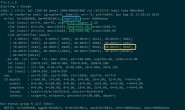本示例演示了下面的线程处理技术。
创建、启动和终止线程
使用线程池
线程同步和互交
ThreadPool.cs
using System;
using System.Threading;
// Fibonacci 类为使用辅助
// 线程执行长时间的 Fibonacci(N) 计算提供了一个接口。
// N 是为 Fibonacci 构造函数提供的,此外还提供了
// 操作完成时对象发出的事件信号。
// 然后,可以使用 FibOfN 属性来检索结果。
public class Fibonacci
{
public Fibonacci(int n, ManualResetEvent doneEvent)
{
_n = n;
_doneEvent = doneEvent;
}
// 供线程池使用的包装方法。
public void ThreadPoolCallback(Object threadContext)
{
int threadIndex = (int)threadContext;
Console.WriteLine("thread {0} started...", threadIndex);
_fibOfN = Calculate(_n);
Console.WriteLine("thread {0} result calculated...", threadIndex);
_doneEvent.Set();
}
// 计算第 N 个斐波纳契数的递归方法。
public int Calculate(int n)
{
if (n <= 1)
{
return n;
}
else
{
return Calculate(n - 1) + Calculate(n - 2);
}
}
public int N { get { return _n; } }
private int _n;
public int FibOfN { get { return _fibOfN; } }
private int _fibOfN;
ManualResetEvent _doneEvent;
}
public class ThreadPoolExample
{
static void Main()
{
const int FibonacciCalculations = 10;
// 每个 Fibonacci 对象使用一个事件
ManualResetEvent[] doneEvents = new ManualResetEvent[FibonacciCalculations];
Fibonacci[] fibArray = new Fibonacci[FibonacciCalculations];
Random r = new Random();
// 使用 ThreadPool 配置和启动线程:
Console.WriteLine("launching {0} tasks...", FibonacciCalculations);
for (int i = 0; i < FibonacciCalculations; i++)
{
doneEvents[i] = new ManualResetEvent(false);
Fibonacci f = new Fibonacci(r.Next(20,40), doneEvents[i]);
fibArray[i] = f;
ThreadPool.QueueUserWorkItem(f.ThreadPoolCallback, i);
}
// 等待池中的所有线程执行计算...
WaitHandle.WaitAll(doneEvents);
Console.WriteLine("Calculations complete.");
// 显示结果...
for (int i= 0; i<FibonacciCalculations; i++)
{
Fibonacci f = fibArray[i];
Console.WriteLine("Fibonacci({0}) = {1}", f.N, f.FibOfN);
}
}
}
ThreadStartStop.cs
using System;
using System.Threading;
public class Worker
{
// 启动线程时调用此方法。
public void DoWork()
{
while (!_shouldStop)
{
Console.WriteLine("worker thread: working...");
}
Console.WriteLine("worker thread: terminating gracefully.");
}
public void RequestStop()
{
_shouldStop = true;
}
// Volatile 用于向编译器提示此数据
// 成员将由多个线程访问。
private volatile bool _shouldStop;
}
public class WorkerThreadExample
{
static void Main()
{
// 创建线程对象。这不会启动该线程。
Worker workerObject = new Worker();
Thread workerThread = new Thread(workerObject.DoWork);
// 启动辅助线程。
workerThread.Start();
Console.WriteLine("main thread: Starting worker thread...");
// 循环直至辅助线程激活。
while (!workerThread.IsAlive);
// 为主线程设置 1 毫秒的休眠,
// 以使辅助线程完成某项工作。
Thread.Sleep(1);
// 请求辅助线程自行停止:
workerObject.RequestStop();
// 使用 Join 方法阻塞当前线程,
// 直至对象的线程终止。
workerThread.Join();
Console.WriteLine("main thread: Worker thread has terminated.");
}
}
ThreadSync.cs
using System;
using System.Threading;
using System.Collections;
using System.Collections.Generic;
// 将线程同步事件封装在此类中,
// 以便于将这些事件传递给 Consumer 和
// Producer 类。
public class SyncEvents
{
public SyncEvents()
{
// AutoResetEvent 用于“新项”事件,因为
// 我们希望每当使用者线程响应此事件时,
// 此事件就会自动重置。
_newItemEvent = new AutoResetEvent(false);
// ManualResetEvent 用于“退出”事件,因为
// 我们希望发出此事件的信号时有多个线程响应。
// 如果使用 AutoResetEvent,事件
// 对象将在单个线程作出响应之后恢复为
// 未发信号的状态,而其他线程将
// 无法终止。
_exitThreadEvent = new ManualResetEvent(false);
// 这两个事件也放在一个 WaitHandle 数组中,以便
// 使用者线程可以使用 WaitAny 方法
// 阻塞这两个事件。
_eventArray = new WaitHandle[2];
_eventArray[0] = _newItemEvent;
_eventArray[1] = _exitThreadEvent;
}
// 公共属性允许对事件进行安全访问。
public EventWaitHandle ExitThreadEvent
{
get { return _exitThreadEvent; }
}
public EventWaitHandle NewItemEvent
{
get { return _newItemEvent; }
}
public WaitHandle[] EventArray
{
get { return _eventArray; }
}
private EventWaitHandle _newItemEvent;
private EventWaitHandle _exitThreadEvent;
private WaitHandle[] _eventArray;
}
// Producer 类(使用一个辅助线程)
// 将项异步添加到队列中,共添加 20 个项。
public class Producer
{
public Producer(Queue<int> q, SyncEvents e)
{
_queue = q;
_syncEvents = e;
}
public void ThreadRun()
{
int count = 0;
Random r = new Random();
while (!_syncEvents.ExitThreadEvent.WaitOne(0, false))
{
lock (((ICollection)_queue).SyncRoot)
{
while (_queue.Count < 20)
{
_queue.Enqueue(r.Next(0, 100));
_syncEvents.NewItemEvent.Set();
count++;
}
}
}
Console.WriteLine("Producer thread: produced {0} items", count);
}
private Queue<int> _queue;
private SyncEvents _syncEvents;
}
// Consumer 类通过自己的辅助线程使用队列
// 中的项。Producer 类使用 NewItemEvent
// 将新项通知 Consumer 类。
public class Consumer
{
public Consumer(Queue<int> q, SyncEvents e)
{
_queue = q;
_syncEvents = e;
}
public void ThreadRun()
{
int count = 0;
while (WaitHandle.WaitAny(_syncEvents.EventArray) != 1)
{
lock (((ICollection)_queue).SyncRoot)
{
int item = _queue.Dequeue();
}
count++;
}
Console.WriteLine("Consumer Thread: consumed {0} items", count);
}
private Queue<int> _queue;
private SyncEvents _syncEvents;
}
public class ThreadSyncSample
{
private static void ShowQueueContents(Queue<int> q)
{
// 对集合进行枚举本来就不是线程安全的,
// 因此在整个枚举过程中锁定集合以防止
// 使用者和制造者线程修改内容
// 是绝对必要的。(此方法仅由
// 主线程调用。)
lock (((ICollection)q).SyncRoot)
{
foreach (int i in q)
{
Console.Write("{0} ", i);
}
}
Console.WriteLine();
}
static void Main()
{
// 配置结构,该结构包含线程同步
// 所需的事件信息。
SyncEvents syncEvents = new SyncEvents();
// 泛型队列集合用于存储要制造和使用的
// 项。此例中使用的是“int”。
Queue<int> queue = new Queue<int>();
// 创建对象,一个用于制造项,一个用于
// 使用项。将队列和线程同步事件传递给
// 这两个对象。
Console.WriteLine("Configuring worker threads...");
Producer producer = new Producer(queue, syncEvents);
Consumer consumer = new Consumer(queue, syncEvents);
// 为制造者对象和使用者对象创建线程
// 对象。此步骤并不创建或启动
// 实际线程。
Thread producerThread = new Thread(producer.ThreadRun);
Thread consumerThread = new Thread(consumer.ThreadRun);
// 创建和启动两个线程。
Console.WriteLine("Launching producer and consumer threads...");
producerThread.Start();
consumerThread.Start();
// 为制造者线程和使用者线程设置 10 秒的运行时间。
// 使用主线程(执行此方法的线程)
// 每隔 2.5 秒显示一次队列内容。
for (int i = 0; i < 4; i++)
{
Thread.Sleep(2500);
ShowQueueContents(queue);
}
// 向使用者线程和制造者线程发出终止信号。
// 这两个线程都会响应,由于 ExitThreadEvent 是
// 手动重置的事件,因此除非显式重置,否则将保持“设置”。
Console.WriteLine("Signaling threads to terminate...");
syncEvents.ExitThreadEvent.Set();
// 使用 Join 阻塞主线程,首先阻塞到制造者线程
// 终止,然后阻塞到使用者线程终止。
Console.WriteLine("main thread waiting for threads to finish...");
producerThread.Join();
consumerThread.Join();
}
}




